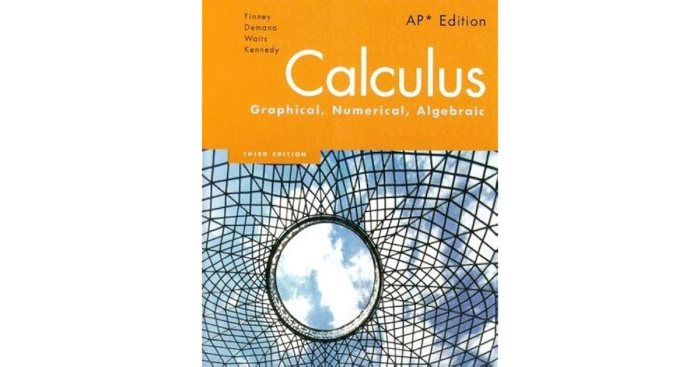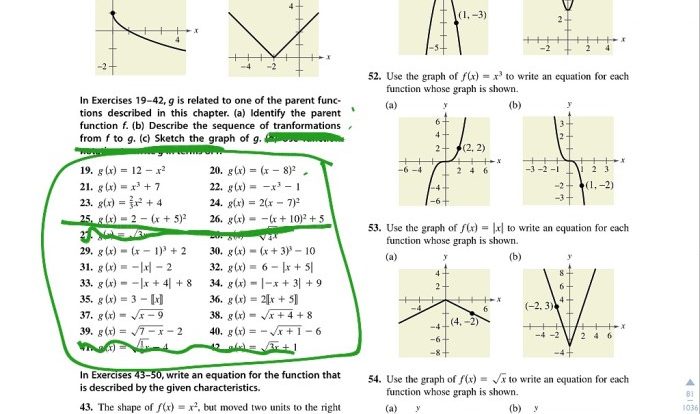Calculus graphical numerical and algebraic, a cornerstone of mathematics, provides a powerful toolkit for analyzing and solving complex problems across a wide range of disciplines. From physics to engineering to economics, calculus empowers us to understand and model the world around us.
This comprehensive guide delves into the fundamental concepts of calculus, exploring the graphical, numerical, and algebraic techniques that underpin its applications. With clear explanations, engaging examples, and insightful discussions, we will uncover the versatility and significance of calculus in shaping our understanding of the universe.
Calculus
Calculus is a branch of mathematics that deals with change. It provides a powerful set of tools for analyzing and solving problems involving continuous change, such as the motion of objects, the growth of populations, and the flow of fluids.
Fundamental Concepts of Calculus
- Limits: The concept of a limit describes the behavior of a function as its input approaches a certain value.
- Derivatives: The derivative of a function measures the instantaneous rate of change of the function.
- Integrals: The integral of a function represents the area under the curve of the function.
Applications of Calculus
- Physics: Calculus is used to describe the motion of objects, such as the trajectory of a projectile or the flow of a fluid.
- Engineering: Calculus is used to design and analyze structures, such as bridges and buildings.
- Economics: Calculus is used to model and analyze economic phenomena, such as the growth of GDP or the demand for a product.
Graphical Representations
Graphical representations are a powerful tool for visualizing and analyzing functions. They can provide insights into the behavior of a function that are not immediately apparent from the algebraic expression.
Types of Graphical Representations
- Graphs of Functions: The graph of a function is a plot of the function’s output values against its input values.
- Slope Fields: A slope field is a graphical representation of the derivative of a function. It shows the direction and magnitude of the derivative at each point in the domain of the function.
- Contour Plots: A contour plot is a graphical representation of a function of two variables. It shows the level curves of the function, which are the curves that connect points of equal value.
Uses of Graphical Representations
- Visualizing Function Behavior: Graphs can be used to visualize the shape of a function, its extrema, and its rate of change.
- Solving Calculus Problems: Graphs can be used to solve calculus problems, such as finding the roots of a function or the area under a curve.
- Modeling Real-World Phenomena: Graphs can be used to model and analyze real-world phenomena, such as the growth of a population or the flow of a fluid.
Numerical Methods: Calculus Graphical Numerical And Algebraic
Numerical methods are techniques for approximating solutions to calculus problems. They are used when it is not possible to find an exact solution.
Types of Numerical Methods
- Numerical Integration: Numerical integration is a technique for approximating the area under a curve.
- Numerical Differentiation: Numerical differentiation is a technique for approximating the derivative of a function.
- Root-Finding Methods: Root-finding methods are techniques for finding the roots of a function.
Uses of Numerical Methods
- Solving Calculus Problems: Numerical methods can be used to solve calculus problems that cannot be solved exactly.
- Modeling Real-World Phenomena: Numerical methods can be used to model and analyze real-world phenomena, such as the flow of a fluid or the growth of a population.
- Computer Simulations: Numerical methods are used in computer simulations to model and analyze complex systems.
Algebraic Techniques
Algebraic techniques are methods for solving calculus problems using algebraic operations. They are often used in conjunction with graphical and numerical methods.
Types of Algebraic Techniques
- Differentiation Rules: Differentiation rules are formulas that allow us to find the derivative of a function.
- Integration Rules: Integration rules are formulas that allow us to find the integral of a function.
- Chain Rule: The chain rule is a technique for finding the derivative of a composite function.
Uses of Algebraic Techniques
- Solving Calculus Problems: Algebraic techniques can be used to solve calculus problems, such as finding the roots of a function or the area under a curve.
- Simplifying Expressions: Algebraic techniques can be used to simplify complex expressions.
- Deriving New Formulas: Algebraic techniques can be used to derive new formulas for calculus operations.
Applications

Calculus has a wide range of applications in various fields, including physics, engineering, economics, and finance.
Physics
- Motion: Calculus is used to describe the motion of objects, such as the trajectory of a projectile or the flow of a fluid.
- Energy: Calculus is used to calculate the energy of a system, such as the kinetic energy of a moving object or the potential energy of a stretched spring.
- Heat Transfer: Calculus is used to model and analyze heat transfer, such as the flow of heat through a material or the cooling of a hot object.
Engineering, Calculus graphical numerical and algebraic
- Structural Analysis: Calculus is used to analyze the strength and stability of structures, such as bridges and buildings.
- Fluid Mechanics: Calculus is used to model and analyze the flow of fluids, such as the flow of water in a pipe or the flow of air around an airplane.
- Electrical Engineering: Calculus is used to analyze electrical circuits, such as the flow of current in a circuit or the voltage across a capacitor.
Economics
- Growth Models: Calculus is used to model and analyze economic growth, such as the growth of GDP or the growth of a population.
- Optimization: Calculus is used to optimize economic decisions, such as the optimal production level of a firm or the optimal investment portfolio.
- Finance: Calculus is used to model and analyze financial instruments, such as stocks, bonds, and derivatives.
FAQ Guide
What are the fundamental concepts of calculus?
Calculus is built upon the concepts of limits, derivatives, and integrals. Limits describe the behavior of functions as their inputs approach specific values. Derivatives measure the instantaneous rate of change of functions. Integrals calculate the area under curves and volumes of solids.
How is calculus used in real-world problems?
Calculus finds applications in countless fields. Engineers use it to design bridges and buildings. Physicists employ it to model motion and forces. Economists utilize it to analyze market trends and optimize investments.
What are the different types of graphical representations used in calculus?
Calculus employs various graphical representations, including function graphs, slope fields, and level curves. Function graphs visualize the relationship between input and output values. Slope fields depict the direction and magnitude of derivatives. Level curves represent surfaces of constant values.
